2017年海南大学832风景园林规划设计考研大纲硕士研究生入学考试大纲
2017年海南大学816民法学、刑法学、民事诉讼法学考研大纲硕士研究生入学考试大纲
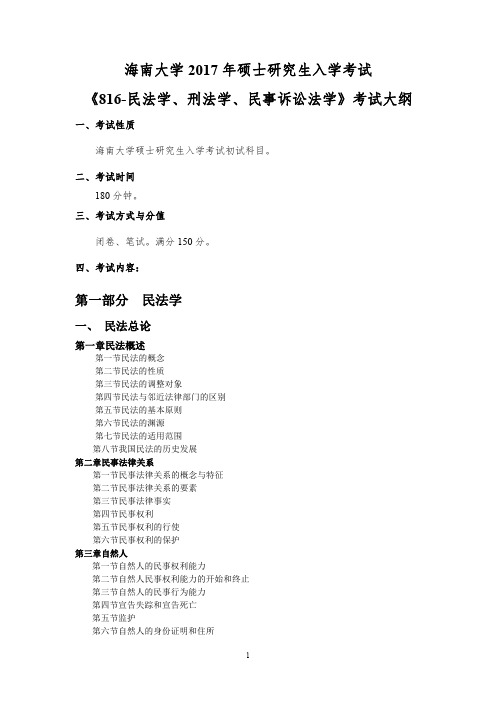
海南大学2017年硕士研究生入学考试《816-民法学、刑法学、民事诉讼法学》考试大纲一、考试性质
海南大学硕士研究生入学考试初试科目。
二、考试时间
180分钟。
三、考试方式与分值
闭卷、笔试。
满分150分。
四、考试内容:
第一部分民法学
一、民法总论
第一章民法概述
第一节民法的概念
第二节民法的性质
第三节民法的调整对象
第四节民法与邻近法律部门的区别
第五节民法的基本原则
第六节民法的渊源
第七节民法的适用范围
第八节我国民法的历史发展
第二章民事法律关系
第一节民事法律关系的概念与特征
第二节民事法律关系的要素
第三节民事法律事实
第四节民事权利
第五节民事权利的行使
第六节民事权利的保护
第三章自然人
第一节自然人的民事权利能力
第二节自然人民事权利能力的开始和终止
第三节自然人的民事行为能力
第四节宣告失踪和宣告死亡
第五节监护
第六节自然人的身份证明和住所
1。
风景园林(专业)硕士考试科目及大纲解析

风景园林硕士初试考试科目
注:
1.括号内所注分值为该栏考试科目试题满分值。
2.加“▲”为全国统考或全国联考试题。
风景园林硕士专业学位研究生入学考试
《风景园林基础》考试命题指导性意见
《风景园林基础》是为各培养单位招收全日制风景园林硕士专业学位研究生设置的专业基础选拔性考试科目。
其目的是科学、公正、有效地测试考生是否具备攻读风景园林硕士专业学位应具备的知识、能力和素养要求,为各培养单位提供择优录取的依据。
《风景园林基础》科目考试命题,各培养单位可按照本意见,分别向考生提供考试大纲并命制试题。
《风景园林基础》
一、考查目标
侧重于风景园林综合知识的考查。
考试内容应主要涵盖风景园林历史、风景园林规划设计及理论、园林植物与应用、园林工程与建筑等课程。
要求考生理解和掌握风景园林基本概念、基础理论和基本方法,能够分析、判断和解决有关实际问题。
二、考试形式和试卷结构 1、试卷满分及考试时间
本试卷满分为150分,考试时间为180分钟。
2、答题方式
闭卷、笔试。
3、试卷内容结构
培养单位可根据自身的条件及需求,从风景园林历史、风景园林规划设计及理论、园林植物与应用、园林工程与建筑等课程中选择三门相关科目命制试卷。
每个科目的内容各为50分。
2017年硕士专业学位研究生入学统一考试自命题大纲.doc

2017年硕士专业学位研究生入学统一考试自命题大纲目录2017年工程硕士研究生入学统一考试复试大纲1交通运输工程(085222) 1《船舶管理》 1《结构力学》 1《土力学》 2《工程流体力学》 3《运筹学》 4《C语言程序设计》 62017年工程硕士研究生入学统一考试加试大纲6交通运输工程(085222) 6《海上交通工程》 6《工程项目管理》72017年农业硕士研究生入学统一考试复试大纲8养殖(095105) 8《普通动物学》8《养殖水域生态学》9渔业(095108) 10《渔业技术学》10《普通生态学》11农业机械化(095109)12《机械制造技术基础》12《控制工程基础》12农村与区域发展(095110)13《管理学理论应用》13《政治学原理》14《中国传统文化》15农业科技组织与服务(095111)15《管理学理论应用》15农业信息化(095112)16《微机原理》16《数据结构》19食品加工与安全(095113)20《水产食品加工学》20《食品技术原理》21设施农业(095114)22《普通生态学》222017年农业硕士研究生入学统一考试加试大纲23养殖(095105)23《鱼类学》23《甲壳动物学》24渔业(095108)24《水生生物学》24《计算机基础》25农业机械化(095109)26《工程图学》26《互换性与技术测量》26《单片机原理及应用》27《信号与系统》28农村与区域发展(095110)28《微观经济学》28《行政管理学》29《文史知识基础》31农业科技组织与服务(095110)31《产业经济学》31《行政管理学》32《教育学》34农业信息化(095112)35《计算机科学导论》35《C++程序设计》 37食品加工与安全(095113)38《食品分析与检验》38《食品微生物学》39设施农业(095114)41《海洋生物学》41《计算机基础》412017年工程硕士研究生入学统一考试复试大纲交通运输工程(085222)《船舶管理》一、考查目标《船舶管理》涉及船舶驾驶人员应知应会的岗位职责和必须遵守的安全生产规章、规则以及国际国内相关法律等知识,对保证人员、船舶和海洋环境的安全是极为重要的一环。
风景园林综合理论考试大纲
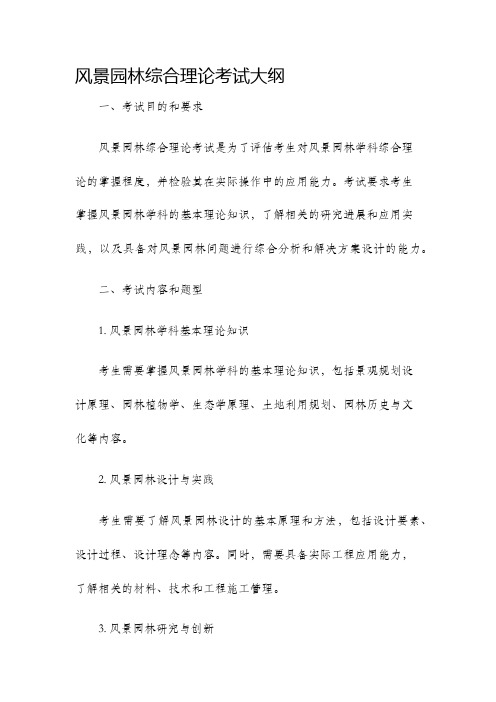
风景园林综合理论考试大纲一、考试目的和要求风景园林综合理论考试是为了评估考生对风景园林学科综合理论的掌握程度,并检验其在实际操作中的应用能力。
考试要求考生掌握风景园林学科的基本理论知识,了解相关的研究进展和应用实践,以及具备对风景园林问题进行综合分析和解决方案设计的能力。
二、考试内容和题型1. 风景园林学科基本理论知识考生需要掌握风景园林学科的基本理论知识,包括景观规划设计原理、园林植物学、生态学原理、土地利用规划、园林历史与文化等内容。
2. 风景园林设计与实践考生需要了解风景园林设计的基本原理和方法,包括设计要素、设计过程、设计理念等内容。
同时,需要具备实际工程应用能力,了解相关的材料、技术和工程施工管理。
3. 风景园林研究与创新考生需要掌握风景园林领域的最新研究进展和创新方法,了解相关的研究论文和学术研讨会。
同时,需要具备独立进行研究和创新的能力,能够提出新颖的研究问题和解决方案。
4. 风景园林规划与管理考生需要了解风景园林规划的基本原理和方法,包括城市规划、景观评价、项目管理等内容。
同时,需要具备规划和管理实践经验,了解相关法律法规和政策文件。
5. 风景园林职业道德与规范考生需要了解风景园林职业道德和规范,包括职业操守、诚实守信、保护环境等内容。
同时,需要具备团队合作和社会责任意识,能够正确处理职业伦理和专业道德问题。
三、考试形式和时间分配风景园林综合理论考试采用笔试形式,总分为100分,考试时间为120分钟。
四、考试评分和合格标准考试采用百分制评分,各个题目的分值根据题目难度和重要性进行设置。
合格标准为60分及以上。
五、考试参考书目1. 《风景园林设计基础》2. 《园艺学概论》3. 《城市绿地规划与设计》4. 《环境管理与风景园林绿化》5. 《风景园林史》六、考试注意事项1. 考试期间不得交流和抄袭,一经查实将取消考试资格。
2. 考试不得携带手机和其他电子设备,考生需遵守考场纪律。
3. 考试过程中要保持安静和秩序,不得干扰其他考生。
海南大学344风景园林参考书目和大纲
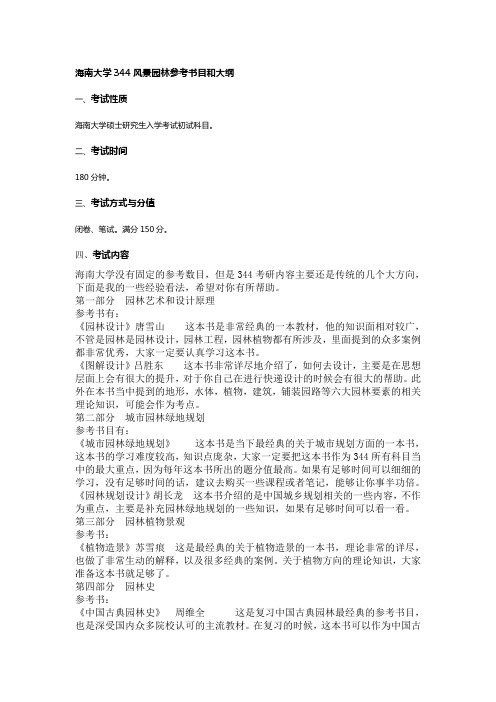
海南大学344风景园林参考书目和大纲一、考试性质海南大学硕士研究生入学考试初试科目。
二、考试时间180分钟。
三、考试方式与分值闭卷、笔试。
满分150分。
四、考试内容海南大学没有固定的参考数目,但是344考研内容主要还是传统的几个大方向,下面是我的一些经验看法,希望对你有所帮助。
第一部分园林艺术和设计原理参考书有:《园林设计》唐雪山这本书是非常经典的一本教材,他的知识面相对较广,不管是园林是园林设计,园林工程,园林植物都有所涉及,里面提到的众多案例都非常优秀,大家一定要认真学习这本书。
《图解设计》吕胜东这本书非常详尽地介绍了,如何去设计,主要是在思想层面上会有很大的提升,对于你自己在进行快递设计的时候会有很大的帮助。
此外在本书当中提到的地形,水体,植物,建筑,铺装园路等六大园林要素的相关理论知识,可能会作为考点。
第二部分城市园林绿地规划参考书目有:《城市园林绿地规划》这本书是当下最经典的关于城市规划方面的一本书,这本书的学习难度较高,知识点庞杂,大家一定要把这本书作为344所有科目当中的最大重点,因为每年这本书所出的题分值最高。
如果有足够时间可以细细的学习,没有足够时间的话,建议去购买一些课程或者笔记,能够让你事半功倍。
《园林规划设计》胡长龙这本书介绍的是中国城乡规划相关的一些内容,不作为重点,主要是补充园林绿地规划的一些知识,如果有足够时间可以看一看。
第三部分园林植物景观参考书:《植物造景》苏雪痕这是最经典的关于植物造景的一本书,理论非常的详尽,也做了非常生动的解释,以及很多经典的案例。
关于植物方向的理论知识,大家准备这本书就足够了。
第四部分园林史参考书:《中国古典园林史》周维全这是复习中国古典园林最经典的参考书目,也是深受国内众多院校认可的主流教材。
在复习的时候,这本书可以作为中国古典园林史复习的基础,但是由于本书非常的厚重,建议大家在复习的时候听取网课或者是网络的一些笔记,这样子能大量的节省时间。
2020-2021海南大学风景园林考研招生人数,考试科目,参考书目,考试大纲
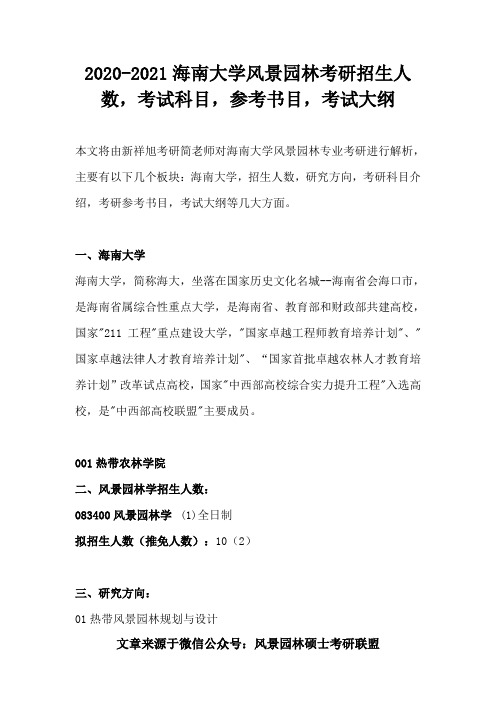
2020-2021海南大学风景园林考研招生人数,考试科目,参考书目,考试大纲本文将由新祥旭考研简老师对海南大学风景园林专业考研进行解析,主要有以下几个板块:海南大学,招生人数,研究方向,考研科目介绍,考研参考书目,考试大纲等几大方面。
一、海南大学海南大学,简称海大,坐落在国家历史文化名城--海南省会海口市,是海南省属综合性重点大学,是海南省、教育部和财政部共建高校,国家"211工程"重点建设大学,"国家卓越工程师教育培养计划"、"国家卓越法律人才教育培养计划"、“国家首批卓越农林人才教育培养计划”改革试点高校,国家"中西部高校综合实力提升工程"入选高校,是"中西部高校联盟"主要成员。
001热带农林学院二、风景园林学招生人数:083400风景园林学(1)全日制拟招生人数(推免人数):10(2)三、研究方向:01热带风景园林规划与设计03热带园林生态与景观规划04热带风景旅游资源开发利用四、考试科目:初试科目:1.101思想政治理论2.201英语一3.344风景园林基础4.832风景园林规划设计(考生自带绘图板、绘图工具及2张A1图纸)复试科目:1011风景园林建筑设计同等学力加试科目:1.园林史2.园林工程五、风景园林专硕招生人数:095300风景园林(专业学位) (1)全日制拟招生人数(推免人数):8(1)六、研究方向:01热带风景园林规划与设计03热带园林生态与景观规划04热带风景旅游资源开发利用七、考试科目:初试科目:1.101思想政治理论2.201英语一3.344风景园林基础4.832风景园林规划设计(考生自带绘图板、绘图工具及2张A1图纸)复试科目:1011风景园林建筑设计同等学力加试科目:1.园林史2.园林工程八、参考书目:《中国古典园林史》(第三版)周维权,清华大学出版社;《中外园林通史》张健主编华中科技大学出版社 2016;《园林规划设计》,胡长龙主编,中国农业出版社;《园冶》,(明)计成,撰,胡天寿,译注,重庆出版社,2009;《风景园林设计》王晓俊,南京:江苏科学技术出版社,2009;《园林工程》,孟兆祯,中国林业出版社,2008年;《风景园林设计要素》[美]诺曼 K.布思著,曹礼昆,曹德昆译,北京:中国林业出版社,2001。
海南大学硕士研究生入学考试
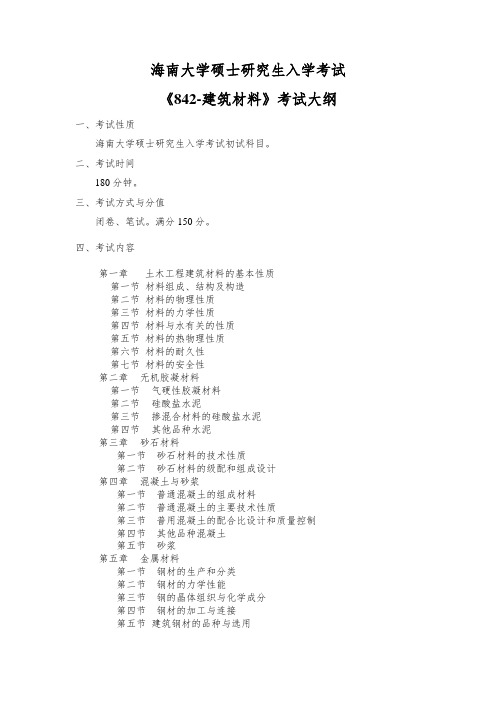
海南大学硕士研究生入学考试
《842-建筑材料》考试大纲一、考试性质
海南大学硕士研究生入学考试初试科目。
二、考试时间
180分钟。
三、考试方式与分值
闭卷、笔试。
满分150分。
四、考试内容
第一章土木工程建筑材料的基本性质
第一节材料组成、结构及构造
第二节材料的物理性质
第三节材料的力学性质
第四节材料与水有关的性质
第五节材料的热物理性质
第六节材料的耐久性
第七节材料的安全性
第二章无机胶凝材料
第一节气硬性胶凝材料
第二节硅酸盐水泥
第三节掺混合材料的硅酸盐水泥
第四节其他品种水泥
第三章砂石材料
第一节砂石材料的技术性质
第二节砂石材料的级配和组成设计
第四章混凝土与砂浆
第一节普通混凝土的组成材料
第二节普通混凝土的主要技术性质
第三节普用混凝土的配合比设计和质量控制
第四节其他品种混凝土
第五节砂浆
第五章金属材料
第一节钢材的生产和分类
第二节钢材的力学性能
第三节钢的晶体组织与化学成分
第四节钢材的加工与连接
第五节建筑钢材的品种与选用
第六节钢材的腐蚀与防止第六章沥青和沥青混合料第一节沥青
第二节沥青混合料。
2017年海南大学342农业知识综合四考研大纲硕士研究生入学考试大纲

海南大学2017年硕士研究生入学考试
《342--农业知识综合四》考试大纲
一、考试性质
海南大学硕士研究生入学考试初试科目。
二、考试时间
180分钟。
三、考试方式与分值
闭卷、笔试。
满分150分。
四、考试内
第一部分发展经济学(50分)
第一章发展经济学:基本对象、理论逻辑结构及其演变和基本研究方法
第二章现代经济增长理论与论证经济发展的基本思路
1.经济增长理论
2.经济发展的基本思路
第三章影响经济发展的国内因素
1.资本资源与经济发展
2.人力资源与经济发展理论
3.技术进步与经
济发展
第四章外部资源利用与经济发展理论
1.利用外资与经济发展
2.国际贸易战略与经济发展
第五章发展战略与经济发展
1.计划与市场控制
2.工业化与城市化路
3.农业问题
第六章发展中国家的可持续发展问题
1.可持续发展的基本思想
2.可持续发展因素分析
3.发展中国家实现可持续发展的基本思路
第七章制度与经济发展
1.交易与交易成本
2.制度及制度变迁
第二部分农业经济学(50分)
1。
- 1、下载文档前请自行甄别文档内容的完整性,平台不提供额外的编辑、内容补充、找答案等附加服务。
- 2、"仅部分预览"的文档,不可在线预览部分如存在完整性等问题,可反馈申请退款(可完整预览的文档不适用该条件!)。
- 3、如文档侵犯您的权益,请联系客服反馈,我们会尽快为您处理(人工客服工作时间:9:00-18:30)。
海南大学2017年硕士研究生入学考试
《832-风景园林规划设计》考试大纲
一、考试性质
海南大学硕士研究生入学考试初试科目。
二、考试时间
180分钟。
三、考试方式与分值
闭卷、笔试。
满分150分。
四、考试内容
通过一个适当面积(一般不超过5公顷)的景观方案设计对学生在现状条件分析研究,设计构思、总体布局、节点设计、植物设计、图面表现及设计说明等方面进行全面考查。
基本内容包括:
1用地现状条件分析图(15%)
2景观设计总平面图(30%)
3各类分析图(包括设计构思、交通分析、分区结构分析图等)若干(根据需要考生自定)(15%)
4节点详细设计图(含平面、立面、剖面图)(20%)
5透视图或鸟瞰图(10%)
6简要设计说明及技术指标(10%)
1。
